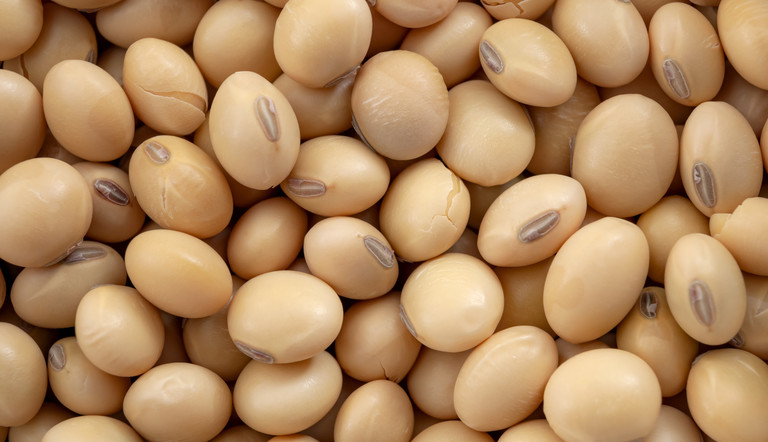
Safeguard Your Soybeans with a Weed Management Strategy
Compared to other crops, soybeans aren’t very competitive at any stage. In fact, they’re particularly susceptible as seedlings; their critical weed-free period stretches from emergence to stage v3i.So whether you’re a first-time grower or a seasoned expert, it’s never too early to start developing a strong weed control plan.

Pre-seed burndowns are essential
According to OMAFRA weed specialist Mike Cowbrough, weeds that come up with or before your crop have the heaviest impact on your yieldii. This is especially true for soybeans, meaning a pre-seed burndown is necessary to set your crop up for success.
For their pre-seed burndowns, many soybean growers rely on herbicides containing the Group 5 active metribuzin, like SQUADRON®II. It treats pre- and post-emergent weeds by inhibiting photosynthesis and can be tank-mixed or used alone in a pre-seed application.
So if you’re finding evidence of broadleaf and grassy weeds like Persian darnel, hempnettle, wild mustard, or any Group 2 resistant weeds, metribuzin is a great choice.
Growers have plenty of options for post-emergent control
Of course, a pre-seed herbicide application typically isn’t enough to clear your field of troublesome weeds for the entire season. Cowbrough recommends scouting for new pests three weeks after your pre-seed burndown, as that’s typically when new weeds begin to emerge.ii
Fortunately, you have a variety of effective chemistries to choose from, meaning you can customize your approach to the weed pressures that exist in your field.
Imazamox
For growers who have Group 1 resistant broadleaf or grassy weeds, or who need residual control of Brassica weeds, look for a herbicide containing imazamox, such as DAVAI® 80 SL. This Group 2 active is effective against cleavers, shepherd’s purse, flixweed, wild oats and volunteer cereals, to name a few, and can be applied to soybeans at emergence through the three-leaf stage.
Imazamox works by disrupting protein-producing enzymes within susceptible weedsiii, essentially starving them to death. While weeds can take up to three weeks to fully die, their growth halts within 48 hours of application, so crop competition is rapidly reduced. For best results, apply to broadleaf weeds between the cotelydon to four-leaf stage and grasses between the 1-4 true leaf stages.
Additionally, some imazamox products, like DAVAI, can be tank-mixed with other actives for customized weed control, making imazamox an effective and flexible option.
Imazethapyr
If you’re looking for early season control of broadleaf weeds, another Group 2 active to try is imazethapyr, commonly sold as PHANTOM® 240 SL. Similar to imazamox, imazethapyr also kills weeds by inhibiting the enzyme essential for protein production, and can be applied to soybeans at the 1-3 leaf stage alone or in a tank-mix.
Growers relying on this active can treat broadleaf weeds, such as chickweed, cleavers, hempnettle, redroot pigweed and shepherd’s purse in the 4-leaf stage and earlier. Imazethapyr is also effective on green foxtail and wild oats between the 2-4 leaf stage.
Clethodim
If you’re mostly finding grassy weeds, like volunteer corn, Persian darnel and volunteer cereals, you may want to try a product containing clethodim. This Group 1 active can be applied on soybeans from first trifoliate through to flowering, either alone or in a tank-mix.
Clethodim, commonly called ARROW® 240 EC, works best when applied to actively growing broadleaf weeds, or grasses/volunteer cereals between the 2-6 leaf stage. Control is most effective when made when annual grasses are small and still growing; typically, prior to tillering.
Diquat
Unlike clethodim, which can be applied pre-harvest as well as in earlier stages, diquat should only be used as a pre-harvest application. This Group 22 active is a desiccant that helps to protect yield and grade while reducing disease transmission and weed competition. It can be tank-mixed with other products and works on contact to disrupt cells of susceptible weeds.
Diquat — commonly sold under the name ARMORY® 240 — can be rainfast in 30 minutes and has a pre-harvest interval of 4-10 days for pulses and soybeans, making it an ideal choice for a pre-harvest application.
For a successful soybean crop, weed control is vital
This is especially true when growing crops like soybeans, which struggle to compete against early-season weeds. Though not exhaustive, this post is a good jumping-off point for developing your weed management plan for the upcoming growing season. And, as always, if you have questions or concerns, please don’t hesitate to contact your local retailer or ADAMA representative.
[i] Risula, Dale. “Preparing for Soybeans in 2018.” Saskatchewan.ca. Online. Accessed 22 February 2018.
[ii] Toblin, Bernard. “Soybean School: Pre + Post = Successful IP Weed Control.” ReaAgriculture.com. Online. Accessed 8 March 2018.